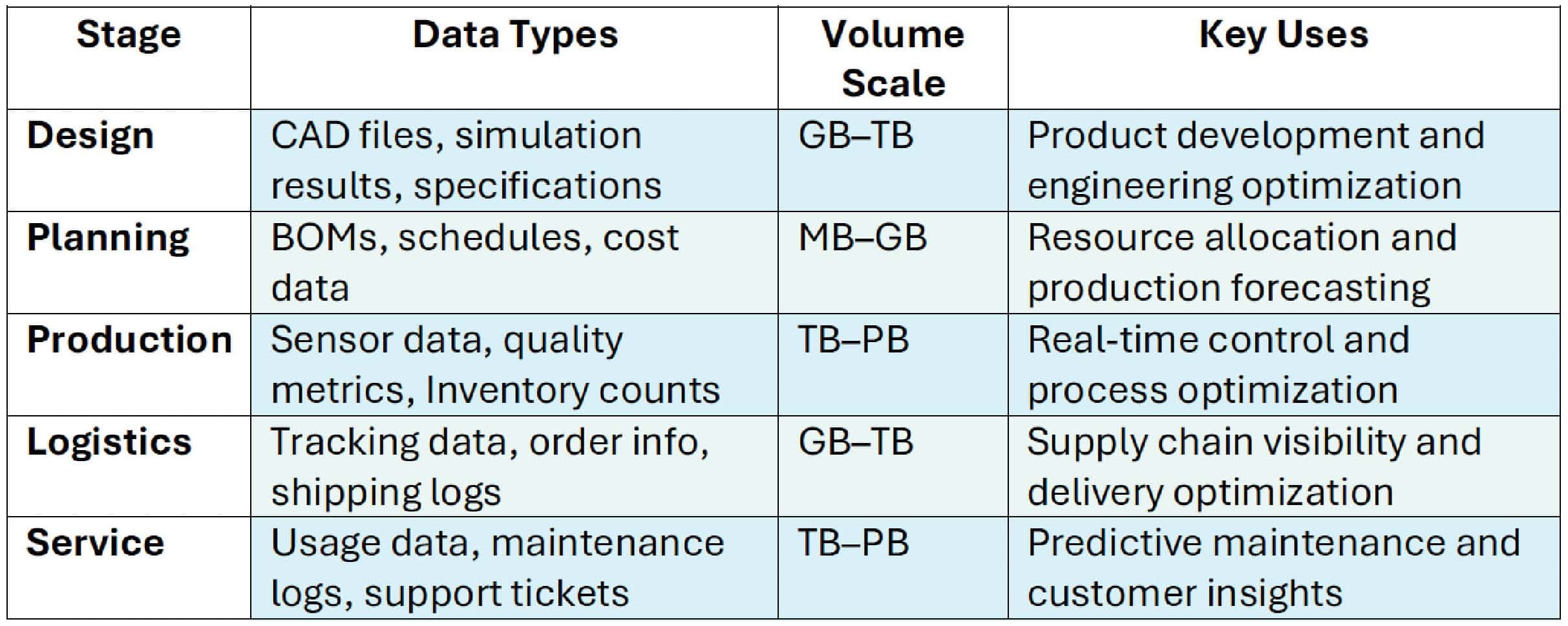Smart Factories, AI, Supply Chains and Data: MLC’s 2025 Surveys
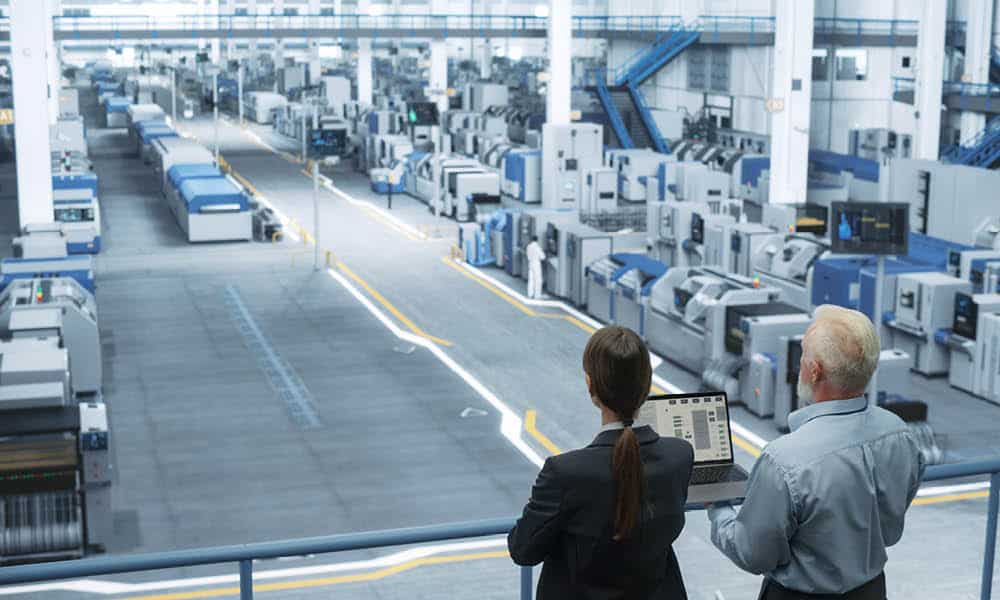
MLC’s 2025 research shows that operations leaders are resolved to continue scaling the digital maturity curve.

In 2025, the Manufacturing Leadership Council’s research efforts studied four areas that are formative to the current state of Manufacturing 4.0: Smart Factories and Digital Production; M4.0 Supply Chains, Artificial Intelligence, and Data Governance, Mastery, and Analytics.
In broad strokes, the surveys paint a picture of manufacturers moving up the digital maturity curve with strong expectations of continuing to advance. Operations leaders see the promise of digitalization, data and AI, but encounter roadblocks for access to capital investment, questions on the business case for technology deployment, and resistance from the workforce and sometimes the C-suite.
Here are the findings from MLC’s 2025 research surveys.
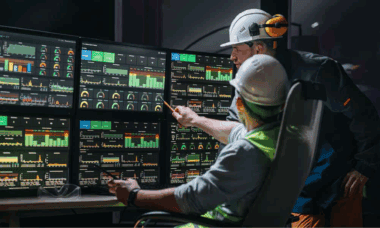
“M4.0 Appears Poised for a Significant Leap”, MLJ February 2025
MLC’s Smart Factories and Digital Production survey showed manufacturers are accelerating their digital transformation, with 60% calling it a defining shift and 75% rating their digital maturity as mid-level. Many companies expect to scale digitization rapidly by 2027—particularly in production, AI-driven operations and smart-factory integration. However, legacy equipment, lack of skilled workers and weak supplier/partner connectivity remain key hurdles.
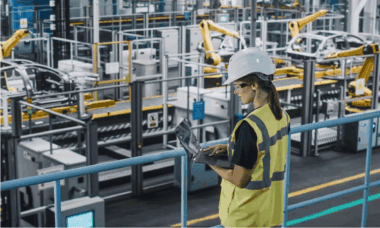
“Tariff Tumult Roils Supply Chains”, MLJ April 2025 – A For MLC’s M4.0 Supply Chains survey, manufacturers said that the Trump administration’s shifting tariff policies created significant supply chain disruption, with 43% experiencing negative impacts at the time of the survey and rising costs cited as the most damaging effect. Nearly half say it is still too early to fully assess the long-term impact, but uncertainty and business strain are widespread. In response, companies are accelerating the use of digital tools—especially supply chain analytics—to improve visibility and resilience in the face of ongoing trade turbulence.
“Shaping the AI-Powered Factory of the Future”, May 2025 – The 2025 Future of Manufacturing Project survey found 68% of manufacturers believe AI will be foundational and most expecting increased investment and adoption over the next two years. While enthusiasm is high, AI use in operations is still limited, and many companies are only beginning to formalize governance and strategy. Significant barriers—including poor data quality, skill gaps, and legacy systems—remain, making steady, iterative progress the key to scaling AI successfully across the industry. Note that you must be logged into the MLC member portal or complete a contact form to access this survey.
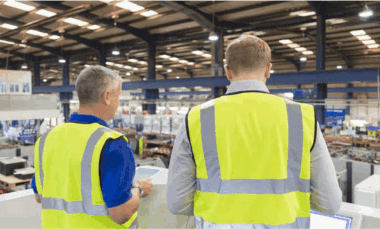
“Manufacturers See Data, Lack Strategy”, October 2025 – MLC’s Data Governance, Mastery, and Analytics survey found that manufacturers increasingly recognize data as a critical asset for digital transformation, driving measurable improvements in cost reduction, efficiency, quality, and decision-making. However, many companies still face significant obstacles, including disparate systems, legacy equipment, limited AI-ready data, and insufficient governance, with nearly half lacking a corporate-wide data strategy. Despite these challenges, firms that effectively harness and validate their data are seeing tangible business benefits and are laying the groundwork for more strategic, data-driven operations. M
About the author:

Penelope Brown is the Senior Content Director, Manufacturing Leadership Council
Welcome New Members of the MLC December 2025
Introducing the latest new members to the Manufacturing Leadership Council

Learn more about MLC membership.

Michelangelo Canzoneri
Global Head of Smart Manufacturing,
Merck Group/EMD

https://www.emdgroup.com/en
![]()
https://www.linkedin.com/in/mcanzoneri/?locale=en_US

Marc Fuentes
Vice President Commercial
Eclipse Automation

www.eclipseautomation.com
![]()
https://www.linkedin.com/in/marcfuentes/

Kevin Hannigan
CEO
InflexionPoint

https://inflexionpoint.ai/
![]()
https://www.linkedin.com/in/kevinehannigan/

Jon Hobgood
Global Head of Smart Manufacturing
GE Healthcare
![]()
www.gehealthcare.com
![]()
https://www.linkedin.com/in/changeagentnow/

Mark Lamoncha
CEO
Humtown Products

https://humtown.com/
![]()
https://www.linkedin.com/in/mark-lamoncha-0792b114/

John McGee
VP, Supply Chain and Operations
Watts Water Technologies
![]()
https://www.watts.com/
![]()
https://www.linkedin.com/in/john-l-e-mcgee/n
Exploring Digital and Physical Convergence at Eclipse Automation
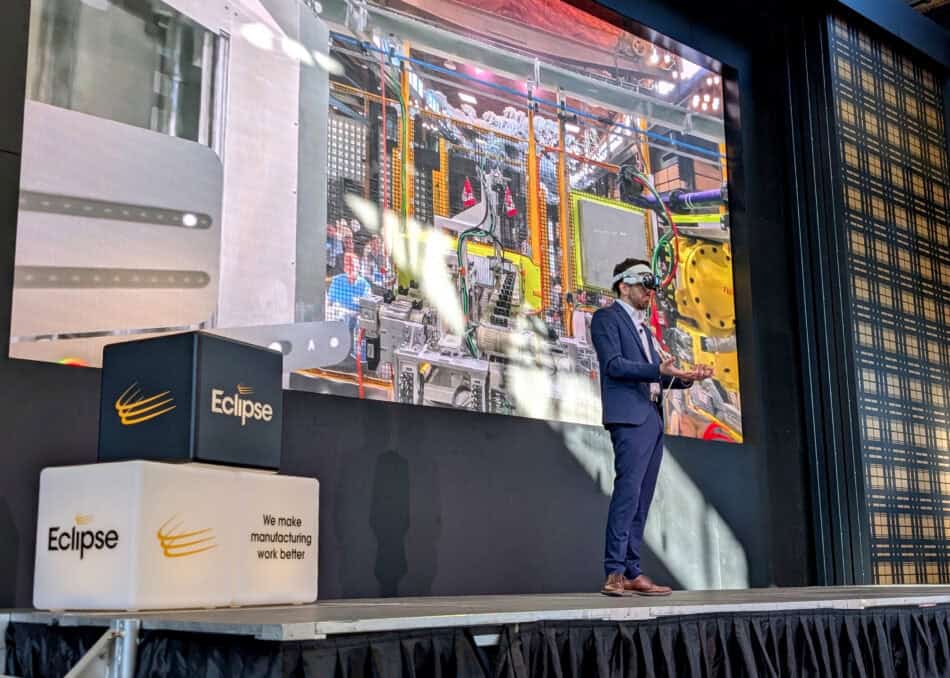
From immersive tech demos to shop-floor innovation, MLC members got an exclusive look at how Eclipse Automation is turning digital transformation into real-world results.
Eclipse Automation opened the doors to its Cambridge, ON facility for MLC members and guests, showcasing the latest innovations in factory automation, digital twins and the omniverse.
The event included a tour of the 200,000 square foot facility, presentations, a panel discussion and opportunities for manufacturers leaders to network and discuss digital and physical convergence and the factory of the future.
Eclipse delivers advanced systems that help manufacturers accelerate production, improve quality and strengthen resilience across industries—from life sciences and transportation to consumer products and electronics. The company’s Cambridge facility serves as both a hub of engineering innovation and a showcase for its latest advancements in smart automation.
Innovation in Action at Eclipse
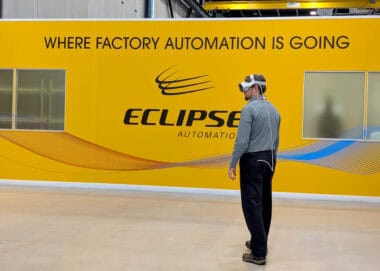
The day began with a welcome from Cambridge Mayor Jan Liggett and an opening keynote by the MLC’s Steven Moskowitz, Ph.D., setting the stage for a day dedicated to digital and physical convergence. Eclipse Automation’s newly appointed president, Michael Fisher, delivered a corporate overview “assembling physical and digital momentum.” Attendees were then immersed in a hands-on Omniverse demonstration, offering a glimpse into the collaborative power of augmented and virtual reality. Using an Apple Vision Pro attached to a projector, participants saw how digital twins and real-time modeling can streamline design decisions and accelerate project timelines.
Inside iPort
The highlight of the morning was the guided tour of Eclipse’s iPort facility, where attendees visited three immersive stops.
- At the Gaussian Splatting Galleria, guests stepped into a virtual workspace that erased physical barriers, revealing new ways to collaborate and problem-solve in real time.
- The Factory Automation Galleria offered a behind-the-scenes look at Eclipse’s innovation process—where ideas move rapidly from concept to prototype to production and projects are derisked.
- Finally, at the Eclipse Experience in Motion stop, visitors walked the active shop floor to observe how Eclipse’s multidisciplinary teams bring complex systems to life.
The tour concluded with a stop at the Technology Galleria, where technology partners demonstrated the tools and platforms shaping where factory automation is going.
Where Digital Meets Physical
In the afternoon, attendees participated in thought leadership presentations and discussions. Breakout sessions covering Smart Manufacturing Playbooks and Generative AI at the Edge were followed by a panel discussion where tour participants were able to ask questions about digital transformation, automation and workforce innovation to a panel of experts.
The tour offered a rare glimpse of the technologies and strategies that are redefining the future of the factory.
Photos and video by Ryan Dentinger, Eclipse Automation
Digital Manufacturing in Action at GM’s Cadillac Plant in Tennessee
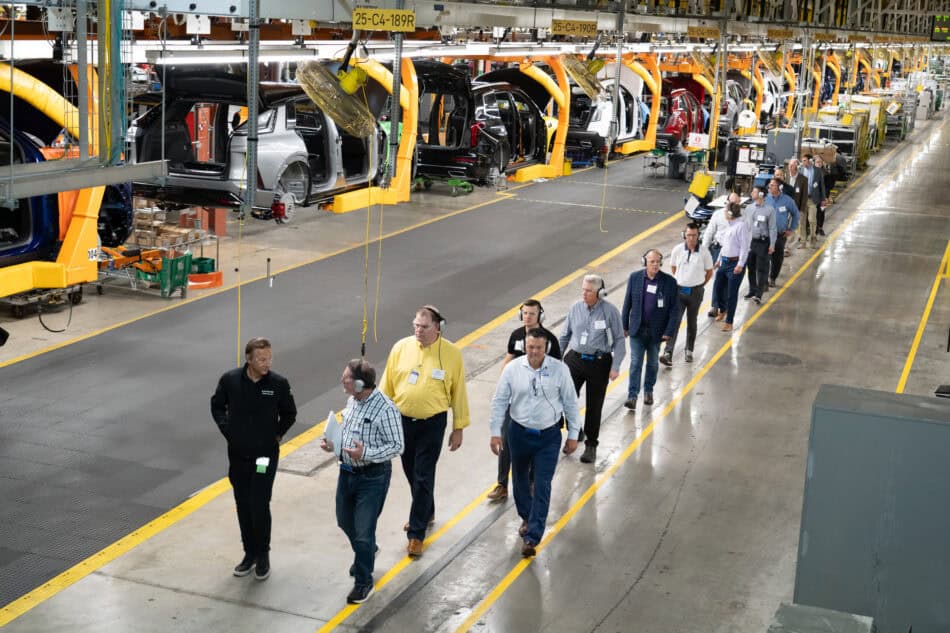
Robotics, AI and people work together to shape the future.
Henry M. Leland, who founded Cadillac in 1902, believed in creating superior products. Cadillac’s early slogan, “The Standard of the World”, reflected his philosophy of establishing a mark of excellence in the automotive industry.
Over the years, Cadillac delivered on that philosophy with innovations that included the pioneering development of interchangeable parts, the first fully enclosed automobile cabin and first electric starter, the first mass produced V8 engine, fuel injection, and many other accomplishments.
The famous Cadillac Crest symbolized Leland’s philosophy. Featuring mythical birds called merlettes, which are derived from the family crest of Antoine de la Mothe Cadillac, the founder of Detroit whom Leland named his automobile after, the crest symbolized a constant striving for excellence. The crest has undergone more than 30 redesigns and even though the merlettes are no longer used in the logo—they do appear as an “Easter Egg” on the LYRIQ’s dashboard—the message of excellence remains.
Today, Cadillac, which General Motors acquired in 1909, remains the premier brand of its $187 billion parent, and is leading GM’s charge in the electric vehicle market. In early September, nearly 100 members of the Manufacturing Leadership Council toured GM’s 11 million-square-foot, 4,000-employee Spring Hill, TN, Cadillac factory to see how Cadillac’s electric LYRIQ and VISTIQ and internal combustion engine-based XT5 and XT6 vehicles are manufactured. The factory will begin building the Chevy Blazer in 2027.
On the Factory Floor
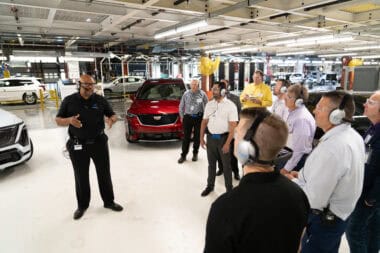 What MLC members saw was a highly automated and digitalized factory that uses robotics and artificial intelligence to improve safety, quality, and efficiency on the manufacturing floor.
What MLC members saw was a highly automated and digitalized factory that uses robotics and artificial intelligence to improve safety, quality, and efficiency on the manufacturing floor.
As one example, GM has a joint venture with LG Energy Solutions to make Ultium cell batteries in Spring Hill.
The batteries are inspected in error proofing stations using cameras and laser stations that check connections. AI is used to detect problems. Together with GM’s Avantguard system, which tracks work sequences and steps, these stations have resulted in a significant drop in warranty issues for customers.
In the assembly operation, MLC members witnessed a GM first—a robot installing a seat in a car on a moving conveyor without human involvement. The operation relies on a vision system and Light Detection and Ranging (LiDAR), a remote sensing method that uses pulses of laser light to measure distances and create 3D models, to align the seat and place it in the precise location while also maneuvering through the door holes.
MLC members also saw how GM mixes vehicle types on the same production line. All five vehicle types produced in the factory, including both EV and internal combustion engine vehicles, are assembled on the same line. Automated mobile robots deliver the proper chassis to each vehicle body as the unfinished cars move down the line. With five different models moving down the line at the same time, the company has paired automation and AI with a surprisingly simple way for workers to identify each vehicle model. A color-coded temporary overlay on the vehicle’s fender signals which vehicle they’ll be working on next.
Beyond the Factory Floor
Breakout session topics included supply chain management and manufacturing optimization. In the supply chain session, tour participants learned that the company’s focus is on simplifying and streamlining supply chain operations so that it can achieve more flexible operations. To improve efficiency, their guiding principle is to fit one more part in every box and move that box one less foot.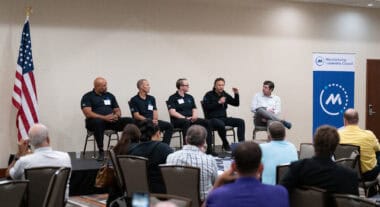
In the optimization session, GM shared that the company’s automation rationale is based on three factors: safety, continuous quality improvement, and efficiency.
According to GM, the best manufacturers know how to get the most out of their technology, equipment, and people—noting that each brings something valuable to the table. The key now is to select the projects that deliver the most ROI while staying true to Cadillac founder Henry Leland’s quest to be the standard of the world.
Photos by David Bohrer/National Assoc. of Manufacturers
How Manufacturers Can Achieve GenAI Success

Manufacturers are increasingly adopting and using generative artificial intelligence, and it is changing their businesses for the better. But for the use of GenAI to be truly transformative, company leadership must ensure their strategy builds on six specific pillars, according to a recent article in the Manufacturing Leadership Council’s ML Journal.
- Establish an AI control tower: Many businesses are spending money needlessly on duplicative GenAI initiatives. Instead, they should set up an AI “control tower,” a centralized hub for AI tools and use cases that lets them reuse assets to save money and speed up implementation.
- Reimagine future business models and functions: Rather than implementing piecemeal updates, companies should consider larger, full-scale revisions with AI. Those that don’t innovate risk being left behind.
- Ensure confidence in AI: Keeping human team members in the loop as GenAI deployments happen will ensure employee confidence in the transformation—as will having a clearly defined set of processes and rules in place to govern algorithm and model creation and use.
- Address talent and tech gaps: Even as the newness of GenAI implementation wears off, it’s important to continue to provide training. A recent EY AI Anxiety in Business survey found that 80% of workers would feel more comfortable using AI if they were trained on it.
- Develop an ecosystem of alliances: To stay ahead of the curve, manufacturers must establish partnerships. These will be critical in filling gaps in their capabilities in an evolving landscape. Specifically, alliances in these four categories are recommended: technology, professional services, academics and data.
- Drive focused data maturity to be AI-ready: When it comes to data maturity, company leaders should aim to be smart and focused. Not every piece of data needs to be pristine to be included in your models. Rather, a firm’s data strategy should be governed by how the data will be used.
The benefits: This strategy should address seven key needs: accessibility at scale, visibility, timeliness, openness, reliability, expansiveness and trust and security.
Nominations are open: The MLC, the NAM’s digital transformation arm, is now accepting nominations for the 2026 Manufacturing Leadership Awards. Learn more here.
How Data Strategy and Governance Can Drive Success for Manufacturers

Unlocking value from data offers manufacturers new opportunities in a shifting economic landscape.

TAKEAWAYS:
● To improve supply chain visibility and overall operations, manufacturers must be intentional in how they harness and use all their data sources.
● Business strategy alignment, data literacy, and the right technology platforms are key to developing a data strategy that supports data governance.
● Manufacturers need a robust data foundation in order to use AI effectively.
From raw material sourcing to product delivery, virtually every manufacturing process generates vast amounts of data. Yet for many organizations, these data remain siloed, underused, or poorly governed, hindering their ability to make informed decisions and fully leverage artificial intelligence (AI) and Internet of Things (IoT)-enabled devices.
Economic uncertainty and a shifting trade landscape make tapping into available data even more critical for driving better decision-making. In multi-layered manufacturing supply networks, organizations that harness information intentionally can use both their internal operational data and data generated from vendors, customers, and other partners to improve supply chain visibility and overall operations.
To seize this opportunity, manufacturers must embrace a clear data strategy that empowers a robust data governance framework. This approach ensures data are trustworthy and accessible, positions organizations to use data as a true strategic asset, and allows them to leverage more advanced technologies such as machine learning, automation, and AI.
Four Pillars of Data Governance
A successful data governance framework is based on four foundational pillars: trusting data, making data available, ensuring data compliance, and understanding the data (see Figure 1). These pillars help organizations cultivate a mindset to operationalize and analyze information at scale.
- Trusting data: Data quality is the bedrock. Manufacturers must be confident that the data they use for supply chain optimization, process improvements, or customer insights is accurate, complete, and reliable. Without trust in data, decision-making becomes risky, and outcomes are more unpredictable.
- Making data available: Accessibility is critical. Valuable data that sit in isolated systems or are confined to one department cannot drive enterprise-wide value. Governed data must be accessible to those who need them, when they need them, while maintaining appropriate access controls.
- Ensuring data compliance: Regulatory requirements, both local and international, are growing in complexity. Manufacturers operate across borders, interacting with myriad vendors and customers. Data governance must ensure compliance with policies, processes, and ever-evolving regulations, protecting both the organization and its stakeholders.
- Understanding the data: Data are only as useful as they are understandable. Clear definitions, standardized formats, and robust metadata enable teams throughout the organization to interpret and apply data appropriately, fueling both operational and analytical initiatives. Organizations also need to understand the systems from which their data originate and the overall lineage of that data. For instance, were there any areas where data may have changed as various partners within the supply chain transmitted that data? Teams need to understand all points along that data journey.
Figure 1: Data governance pillars

The Importance of a Clear Data Strategy
Data governance frameworks cannot exist in isolation or as reactive, one-off projects. Instead, they must be embedded as a program through a deliberate, forward-looking data strategy that aligns with organizational goals and evolving market landscapes. A clear data strategy provides the vision, structure, and prioritization necessary to make governance actionable and effective.
For manufacturers, the need for such a strategy is acute. The industry is characterized by complex supply chains, a diverse range of vendors and customers, and rapidly advancing technologies such as enterprise resource planning systems and fleets of IoT-enabled machinery. Every innovation and new data source increases both the challenge and the potential reward of effective data governance.
A robust data strategy helps determine which data are most important and why. This allows manufacturers to contextualize governance framework needs and focus resources on areas that drive the most value. A clear data strategy defines the organization’s roadmap for the next several years and should be closely tied with business goals and broader business strategy. The data strategy and other digital transformation initiatives within the company should also be intentionally aligned and inform each other on an ongoing basis.
Data as a Strategic Asset
Treating data as an asset can shift the organizational mindset from passive record-keeping to active value creation. In this context, data become a foundational resource akin to capital, talent, and technology.
This perspective can have profound implications. The rise of IoT devices in manufacturing plants, for instance, provides companies with new sources of data that can yield insights into operations. When governed and analyzed effectively, that data can unlock new efficiencies, reveal actionable insights, and enable predictive maintenance or smart product innovation. The difference between success and failure rests on whether manufacturers have the right frameworks to trust, access, and interpret their data.
A strong data foundation is also key for companies to implement AI effectively. “Garbage in, garbage out” is especially true here: without clean, well-governed data, even the most sophisticated AI tools will struggle to deliver meaningful results.
Three Key Data Strategy Considerations
Building a data strategy that supports effective governance requires manufacturers to address three critical considerations: align business strategy with long-term goals, cultivate data literacy and assign roles, and select and enable the right technology platforms.
- Align business strategy and long-term goals: A data strategy must flow from a clear understanding of organizational objectives. Consider these questions: Where is the business headed in the next one, three, or five years? What are the focus areas for growth, efficiency, or innovation? The answers to these questions should inform which data products are prioritized, how they are governed, and how value is measured.
If supply chain visibility is a strategic priority, for instance, then data governance efforts should focus on ensuring the quality, availability, and compliance of supply chain-related information. - Cultivate data literacy and assign roles: Data governance initiatives can only succeed if teams are empowered and accountable in their use of data. This means investing in data literacy across the organization and ensuring that the right roles and responsibilities exist to execute the strategy.
From data stewards responsible for quality and compliance to analysts and business users interpreting insights, everyone must understand both the importance of data and how to use that data effectively. Training, clear communication, and a culture of curiosity and improvement are essential as new technologies and data sources enter the manufacturing environment. Having a change management plan in place can help with these efforts and overall adoption. - Select and enable the right technology platforms: Technology is the enabler that binds data strategy and governance together. The first step in governance is not governance itself but building toward a centralized source of truth with a modern data platform that supports integration, automation, and scalability while iteratively applying data governance processes and accountability along the way.
Manufacturers should invest in platforms that not only collect and store data but also facilitate sharing, security, and advanced analytics. Centralizing data reduces duplication of effort, minimizes errors, and ensures consistency in how governance policies are applied. Platforms must also be flexible and ready to accommodate new data streams from IoT devices, AI tools, and other digital transformation initiatives. The focus here should be on applying governance as the organization grows, as centralized data allow for better visibility and control of that data.
The Takeaway
For manufacturers, the journey from data chaos to data value starts with a clear, actionable strategy. By focusing on the four pillars of governance—trust, availability, compliance, and understanding—and embedding them into a strategy aligned with business goals, manufacturers can unlock their data’s potential. M
About the authors:

Ravi Bodla is a principal at RSM US LLP.

Liz Rizzi is a manager at RSM US LLP.
Mastering Manufacturing Data for Real Advantage
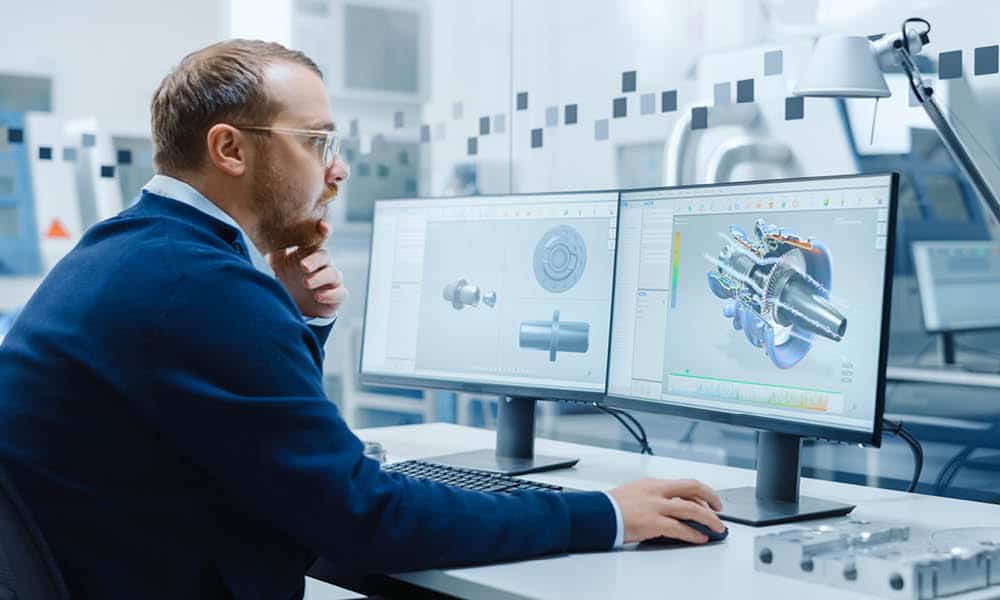
It isn’t about collecting more data—it’s about building trust, reliability, and governance to act with confidence.

TAKEAWAYS:
● Manufacturers generate massive volumes of data across design, production, logistics, and service, but fragmented systems prevent its effective use.
● Reliable data requires a governance framework that prioritizes quality, availability, lineage, ownership, and integration health as non-negotiables.
● Achieving data mastery is a staged transformation—beginning with strategy and governance, piloted through early wins, and scaled with continuous monitoring.
Manufacturing has never been short of data. Across the lifecycle, the streams are relentless. Design teams generate gigabytes to terabytes of CAD, simulations, and specifications. Planning adds bills of materials, schedules, and cost structures. At the production stage, the firehose opens: sensors, quality metrics, and inventory signals push into the terabyte-to-petabyte range. Logistics contributes tracking and order flows; service adds usage and maintenance histories of similar magnitude. In most factories, the production stage alone accounts for the majority of enterprise data.
Table 1: Data types and volumes across manufacturing stages
What most organizations lack is not information, but trustworthy information—data that is complete, contextualized, and ready to drive a decision now, not after a post-mortem. The short answer to why this is the case: Data production has outpaced absorption.
Most manufacturers have built systems over years, not as a unified fabric but as islands. Operations tech streams millisecond sensor data while enterprise apps still batch overnight. Vendors speak different dialects, IDs don’t match across product, process, and resource, and revisions in PLM rarely flow cleanly to MES or quality systems. The consequences are predictable: delays, re-keying, rising costs, and a persistent disconnect between teams. When data is fragmented, people optimize locally. The enterprise loses.
Reliability as an Operating Principle
Without a governance spine, more data doesn’t mean more truth, it means more delay. The first step is to make reliability an operating KPI, not an afterthought. That means treating five dimensions as non-negotiable:
- Quality: Accuracy, completeness, and timeliness
- Availability: The feed is up when operations need it
- Lineage: We can trace where numbers come from and how they were transformed
- Governance: Clear ownership, access, and compliance
- Integration health: Connections sync with minimal failure
To ensure progress, set explicit targets: think 95%+ accuracy, 99.9% availability, full traceability, and sub-1% sync failures, and audit them on a regular cadence.
When organizations do this consistently, reliability scores rise quickly, and with them, decision speed and confidence.
Data Mastery is a Transformation
Data mastery is a staged change program. It starts with sponsorship and ownership—an executive mandate, accountable data stewards, and an honest inventory of today’s assets and pain points. The next step is to design the operating model—principles, decision rights, policies on quality, privacy, and security, and map the practical workflows for the data lifecycle, issue resolution, and change management.
Implementation should begin with focused pilots in high-value domains, coupled with data literacy training and enablement. Technology follows purpose: catalogs, observability, quality monitors, and automation to sustain new ways of working. Finally, it is run as an operation —dashboards, scorecards, compliance reporting, and a discipline of continuous improvement and periodic governance reviews.
Table 2: A model step by step approach to mastering manufacturing data

The Payoff: Trust in Action
The organizations that will win are not those that collect the most data, but those that can trust their data enough to act on it—confidently, repeatedly, and at scale. When reliability becomes habit, analytics stop arguing with operations. Engineers change a design and see the impact upstream and down. Planners simulate scenarios they believe. And most importantly, operations leaders move from firefighting to foresight. M
About the author:

Buddhi Ratawal is Senior Manager, Strategic Business Development at DELMIA.
From Legacy to Leading Edge: Real Stories of Data-Driven Transformation

Four company stories highlight the essential role of effective data management and analysis for competitive advantage.

TAKEAWAYS:
● Companies struggle with outdated legacy systems and practices; they must modernize to gain both short- and long-term advantages.
● Establishing a data-driven culture requires a delicate balance of technology, people, and processes aligned to unlock the data’s value.
● Companies need to embrace and leverage AI to maximize value from their data.
In an era where data reigns supreme, organizations are reevaluating their data strategies. The challenge lies not only in collecting vast amounts of information but also in transforming that data into actionable insights that drive meaningful change.
Many companies are overwhelmed, ensnared by legacy systems and outdated practices. Others are boldly stepping into the future, harnessing the power of analytics and artificial intelligence (AI) to redefine their operations.
The journey toward a data-driven culture requires a delicate balance of technology, people, and processes, all aligned toward a common goal: unlocking the true potential of data. As organizations embark on this path, they recognize that success depends not only on the tools they deploy but also on the foundational elements that support them.
What does it take to cultivate a thriving data ecosystem? How can companies navigate the complex terrain of data management, governance, and analytics to foster a culture of innovation? The answers lie in the diverse experiences of organizations that have ventured down this path, each facing its own unique challenges and triumphs.
Solving the Puzzle
The following client stories provide insights into the strategies employed by four different companies, each addressing unique challenges in data management and analytics. Through these narratives, we will explore how they confronted their obstacles, leveraged technology, and ultimately redefined their operational frameworks. Together, these stories not only highlight the diverse approaches to data transformation but also illustrate how each piece is essential for achieving a fully optimized system.
Breaking the Mold: Reinventing Data Management
Imagine a prominent chemicals company, rich in history and innovation, suddenly realizing that its data infrastructure is hindering its progress. With a patchwork of outdated systems and siloed information, the organization faces a daunting challenge: how to leverage data to fuel its ambitious growth strategy. It becomes clear that a comprehensive enterprise data strategy is not just a nice-to-have; it is essential for survival in a competitive market.
The work begins with a deep dive into the company’s IT setup. A thorough review reveals that the organization lacks a mature data foundation, which is vital for effective visibility and decision-making. Specifically, there are no clearly defined data products—domain-specific solutions that aggregate and present data in ways that align with strategic business needs across various functions such as procurement, supply chain, and finance.
The lack of a structured data framework prevents the current operating model from scaling to meet future demands. Leadership faces challenges due to a lack of actionable metrics and key performance indicators (KPIs) essential for informed decision-making across the value chain.
This critical moment sparks a pivotal decision: to seek external expertise to help the company develop a comprehensive data strategy. The goal is to build a robust, domain-specific data foundation that improves visibility and empowers executive leadership to make informed, data-driven decisions. By enhancing their data maturity and investing in business intelligence and reporting capabilities, the organization can transform its approach to data management and analytics.
“The chemicals company’s experience exemplifies the importance of treating data as a strategic asset.”
Business units gain the autonomy to access and analyze data independently, decreasing their reliance on IT. This newfound independence allows teams to generate insights on their own, resulting in faster decision-making and a greater sense of ownership over their data.
As this transformation unfolds, the company experiences immediate benefits. Engagement with business stakeholders increases, and there is a clear sense of direction in data initiatives. By aligning their data strategy with strategic business goals and investing in the right technology, they unlock value previously trapped in legacy systems.
The chemicals company’s experience exemplifies the importance of treating data as a strategic asset. By embracing change and fostering a culture of data-driven decision-making, they not only laid the foundation for future growth but also positioned themselves to capitalize on new opportunities in an ever-evolving landscape. Their story serves as a powerful reminder that with the right mindset and strategy, organizations can turn their data challenges into catalysts for success.
Key Learnings: Establishing a robust data management operating model is crucial for creating a scalable foundation that aligns with strategic business goals and promotes a culture of data-driven decision-making. It’s also essential to build solutions around the data currently available, even if it isn’t perfect, rather than waiting for flawless data before taking action.
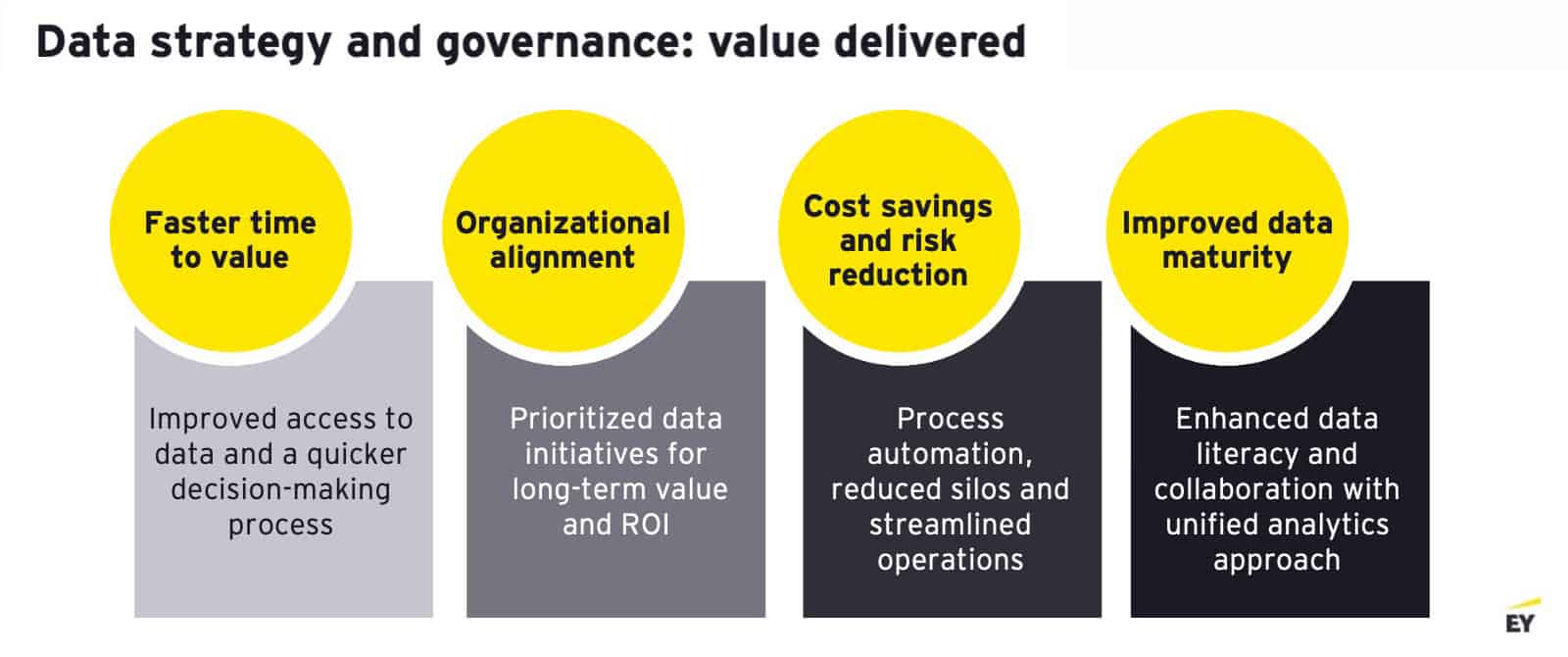
Transforming Data, Realizing Value: Quick Wins in a Long-Term Strategy
Faced with the challenge of consolidating over 70 legacy systems, a leading water management company embarked on an ambitious project to unify these disparate systems into a single, streamlined solution. The stakes were high, as the company had invested millions in a new enterprise resource planning (ERP) system, but the true value of that investment remained untapped, waiting to be unlocked through effective data management and analytics.
As it began this ERP overhaul, the company quickly realized that merely replacing old systems wouldn’t suffice. They needed a strategy that enabled real-time access to and use of their data, even during the transition. This realization led to a pivotal decision: to implement a unified layer of analytics that would connect their legacy systems with the new ERP system.
The project commenced with a focus on user experience. The company introduced a dashboard that provided employees with seamless access to data, regardless of its source—whether from the legacy systems or the new ERP. This innovative approach allowed users to continue their work without interruption, as the outdated systems were phased out, enabling them to derive insights and make informed decisions without waiting for the entire ERP consolidation concludes.
“By prioritizing data accessibility and fostering a culture of analytics, the water management company not only navigated its transformation successfully but also positioned itself for future growth.
As the project progressed, the company experienced a shift in mindset. It moved away from the traditional waterfall approach, where analytics was often an afterthought, and instead made data a central component of its strategy. This proactive approach allowed the company to realize value almost immediately, achieving 80 percent to 90 percent of its desired outcomes even before the full implementation was completed.
The benefits were clear. The company enhanced the visibility of inventory management across its manufacturing sites, facilitating better planning and resource allocation. The company leveraged its data to drive operational efficiencies and enhance decision-making processes, all while maintaining a focus on the ultimate goal of achieving a fully optimized ERP system.
This water management company’s journey exemplifies the power of innovative thinking in addressing complex challenges. By prioritizing data accessibility and fostering a culture of analytics, the company not only navigated its transformation successfully but also positioned itself for future growth.
Key Learning: Implementing a unified layer of analytics enables companies to access and leverage data in real time, effectively bridging the gap between legacy systems and new technologies.
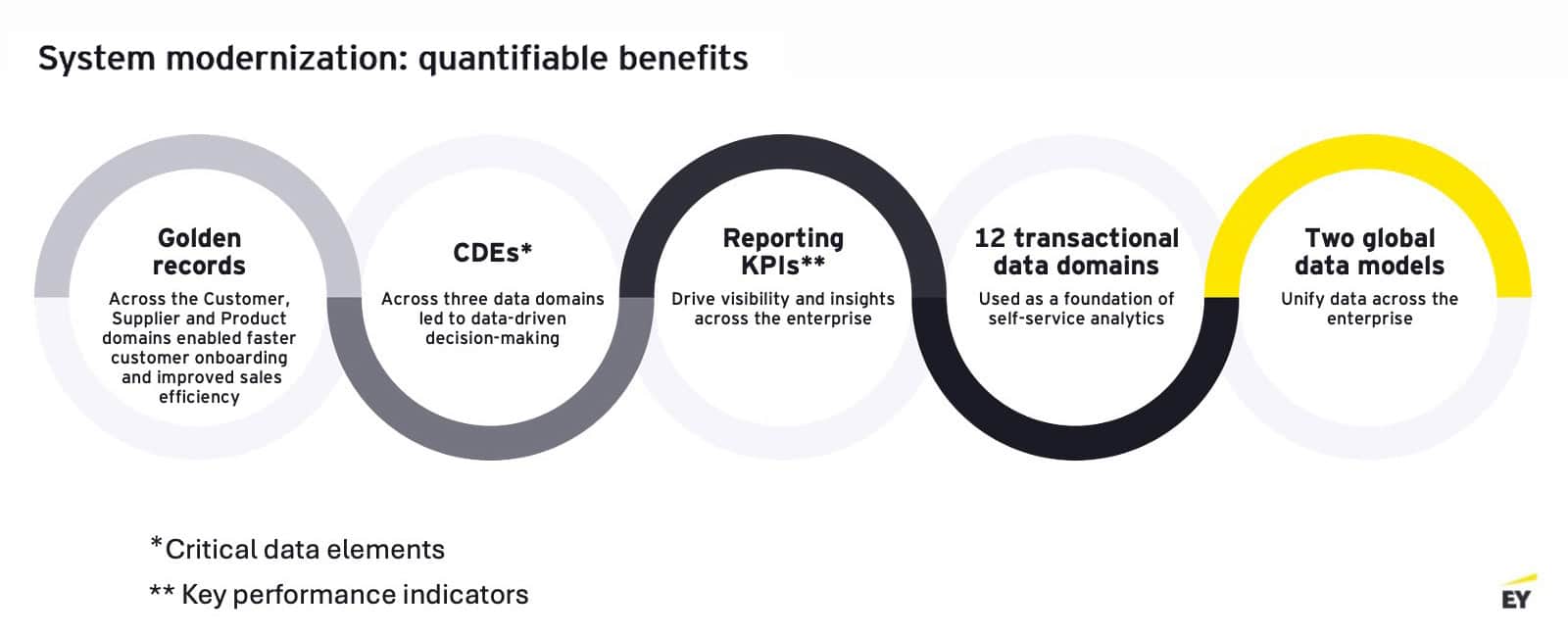
Embracing AI for a Modern Workforce
The journey at this global manufacturing company began with a leadership change, marked by the arrival of a new chief information officer (CIO) who recognized the urgent need for ERP modernization. With a significant overhaul of ERP on the horizon, the company faced the challenge of integrating numerous legacy systems across its manufacturing and distribution operations in North America. The imperative was clear: how could the company modernize its digital capabilities to keep pace with the evolving market?
The CIO quickly pinpointed a fragmented data ecosystem as a major obstacle, resulting from inadequate technology investments over the past decade. However, this realization also revealed numerous opportunities for innovation across various business functions, including aftermarket service, sales, warranty, and supply chain. The focus shifted to two critical objectives: building an enterprise data platform to enable a data-driven culture and incorporating AI into daily decision-making processes.
Initial plans for the AI strategy began to take shape during an innovation session, where the leadership team envisioned an AI platform as a tool for the company to learn and apply AI to its daily operations. This vision generated excitement and ownership around the initiative, marking the start of a transformative journey aimed at harnessing AI’s potential while establishing a robust data foundation.
“Motivated by the potential for a more conversational interface, the manufacturer aimed to leverage GenAI to streamline and improve service delivery.”
As planning progressed, the company’s existing structure required a careful approach to bridge the gap between employees and leadership, often from different geographies. Additionally, the implementation of AI tools required multilingual support to accommodate leaders who preferred communication in other languages. This dual focus on culture and language was essential for fostering acceptance and engagement.
As a manufacturing entity, the organization also grappled with the complexities of fragmented IT systems and siloed operations. Change management became a crucial aspect of the deployment, as building trust in the new systems proved challenging. It was recognized that without intentional investment in internal buy-in, the rollout could face roadblocks.
To empower the workforce, practical AI solutions were introduced to enhance daily operations. Simple yet effective use cases, such as summarizing virtual meetings and drafting emails, demonstrated the immediate benefits of AI integration. For instance, finance leadership leveraged the platform to analyze financial data securely, enabling quicker identification of gaps and opportunities. These early successes demonstrated the value of AI, fueling momentum for long-term initiatives and reinforcing the commitment to digital transformation.
Key Learnings: Successful AI integration requires strong cultural alignment, intentional change management, and practical applications that empower employees to embrace new technologies.
Revolutionize the Dealer Experience
This manufacturer’s story highlights proactive investment and strategic foresight. Over the past decade, the company has established a robust data foundation, cultivating a best-in-class ecosystem for managing connected products and fleet operations. With a high position on the data maturity scale, the company recognized the potential of generative AI (GenAI) to enhance its offerings, particularly in fleet management and aftermarket growth.
The rise of GenAI prompted leadership to explore how these technologies could transform the dealer experience. Although existing digital applications were effective, service technicians faced challenges navigating multiple screens for troubleshooting. Motivated by the potential for a more conversational interface, the company aimed to leverage GenAI to streamline and improve service delivery.
This intentional approach to innovation was reflected in the development of a service technician application that uses legacy knowledge documents and service manuals. By simplifying processes and enhancing customer service, the goal was to demonstrate the value of AI to leadership and secure further investment for scaling these initiatives.
Continuous feedback loops with the dealer network underscored the importance of customer-centricity. The company recognized that a strong advisory board could facilitate direct communication, ensuring dealer insights were integrated into the development process. This collaborative approach defined success criteria and fostered a sense of ownership among dealers, enhancing the overall experience.
There was also acute awareness of the need for responsible AI deployment. As the manufacturer embraced GenAI, it prioritized data security and governance, establishing guardrails to mitigate risks associated with external rollouts.
As with any transformative initiative, challenges arose. The complexity of coordinating cross-functional teams and managing diverse stakeholder expectations necessitated an iterative approach. By piloting solutions early and gathering feedback, the manufacturer ensured that innovations aligned with user needs and expectations.
Key Learnings: Leveraging AI for growth requires a customer-centric approach, continuous feedback loops, and a commitment to responsible innovation that addresses both opportunities and risks.
Conclusion
Organizations increasingly recognize the vital role of effective data management and analytics. Embracing modern technologies like AI and unified analytics enables companies to drive value through operational efficiencies. As they navigate the future, companies should consider how their data strategies can not only yield immediate results but also shape their long-term vision and purpose. M
The views reflected in this article are those of the authors and do not necessarily reflect the views of Ernst & Young LLP or other members of the global EY organization.
About the authors:

Faisal Alam is EY Americas industrials and energy technology leader.

Farooque Munshi is EY Americas data and AI advanced manufacturing leader.

Gundeep Singh is principal, industrial products, Ernst & Young LLP.

Ellen McNally is manager for EY US technology consulting. She contributed to this article.
5 Key Questions on the Path to Industrial DataOps

Industrial DataOps enable manufacturers to be more agile, improve continuously, and move toward smart manufacturing.

TAKEAWAYS:
● Industrial DataOps solutions enable real-time data flows across hardware and software.
● Manufacturers can use data connectivity to respond quickly to emerging risks and constraints across their facilities and the supply chain.
● Manufacturers need to focus on turning raw data into useful information to drive decision-making.
Most manufacturers are on a technology journey, increasingly adopting automation, analytics, and active sensors. In the next two years, 41 percent of manufacturers plan to prioritize investments in factory automation hardware, and 40 percent plan to invest in analytics, according to Deloitte’s 2025 Smart Manufacturing and Operations survey.
The common denominator for these and other technology investments is data. As manufacturers advance, there is a fast-growing imperative to establish foundational capabilities in data quality, connectivity, and access. One effective approach to achieving this is through Industrial DataOps.
Many enterprises are currently working to leverage a unified namespace (UNS), an architectural strategy that centralizes data sources into a single source of truth. A UNS provides a real-time view of the business, and Industrial DataOps facilitates this process at scale. As data silos diminish through a UNS, Industrial DataOps solutions enable real-time data flows across hardware and software, whether at the edge, on-premise, or in the cloud. This robust data foundation paves the way for enhanced agility in the face of constraints, fosters new insights for continuous improvement, and supports the transformation to smart manufacturing.
In adopting an Industrial DataOps strategy, manufacturers should consider five essential questions:
- What criteria should shape our data product priorities for long-term impact?
- How can we foster local innovation without sacrificing global data standards for creating silos?
- How does talent and structure limit our ability to turn data into actionable information, and how can we bridge those gaps?
- What cultural and operational shifts are needed to embed and scale DataOps sustainably?
- How can we design our DataOps strategy to support future AI needs while managing data quality and governance?
1. Shaping Data Priorities for Long-Term Impact
With DataOps, manufacturers convert centralized information into actionable insights. Manufacturers grapple with large, complex data flows from IT and operational technology (OT) infrastructure. With numerous opportunities available, it can be challenging to determine where to begin.
To achieve widespread DataOps use, a data product strategy can be implemented incrementally, capturing value along the way. Initially, manufacturers might focus on the factory floor, developing data products related to bills of materials, parts and inventory, and work instructions. These early solutions demonstrate value, foster relationships and repeatability, and lay the groundwork for more ambitious DataOps applications.
“To achieve widespread DataOps use, a data product strategy can be implemented incrementally, capturing value along the way.”
Once progress is made at the factory level, manufacturers can broaden their focus to data products that span facilities. These might include supply chain data products to clarify incoming supply and demand, products for product lifecycle management (PLM) as it relates to engineering, products for orders and customer demand, and downstream products for quality control and aftermarket service.
Ultimately, manufacturers should start by identifying specific business problems that data products can resolve while also envisioning how to maximize value delivery at scale.
2. Foster Local Innovation without Sacrificing Standards
The emergence of generative AI (GenAI) has sparked a wave of experimentation across various levels, from the factory to the enterprise. New proofs of concept (POCs) have emerged in many areas, raising challenges around AI governance and the coordination of experiments within a broader, strategic framework. Similarly, DataOps presents the challenge of balancing innovation with control. Organizations must grant teams a degree of freedom to experiment while also ensuring adherence to standards critical for maintaining interoperability, scalability, and data quality.
Discovering where DataOps can unlock visibility may be best approached with both top-down and bottom-up strategies for identifying opportunities. For example, building data products for PLM is a global initiative, as products should be consistent across the manufacturing footprint.
Conversely, when it comes to OT data within the factory walls (e.g., from SCADA systems), manufacturers can manage data products at the facility level while leveraging tools and frameworks defined at the enterprise level. This approach allows for innovation within facilities that is permitted, governed, and strategically aligned.
3. Bridging Gaps and Turning Data into Action
Implementing DataOps requires specific technical skillsets. Manufacturers will need data engineering talent to plan and implement a UNS, as well as data architects to manage data structure. Cloud computing skills are essential for setting up platforms and infrastructure to capture the right data (rather than all data).
“Some manufacturers may pursue building services and solutions based on their data products, making the development of DataOps a core competency.”
However, merely collecting data is not sufficient. Manufacturers must also focus on transforming raw data into meaningful information that can drive decision-making and insights. This requires data owners within the business who are accountable for managing and maintaining data quality, context, and relevance. In the long term, as the data foundation supports increasingly ambitious automation, there will likely be a heightened demand for skilled talent in data science, machine learning, and AI modeling.
To attract top candidates, manufacturers may need to increase pay rates and ensure their global workforce strategy is guided by leaders with robust skills and experience in data and technology.
4. Cultural and Operational Shifts for DataOps
Even with the right skilled labor, adopting a UNS and DataOps can be challenging. Manufacturers will require an ecosystem of partners and providers with the necessary tools and capabilities to support their journey. Some manufacturers may pursue building services and solutions based on their data products, making the development of DataOps a core competency.
For most manufacturers, however, this domain is often deprioritized because, while it is foundational, it typically does not serve as an immediate performance differentiator. Achieving success requires a balance between daily operations, limited talent and funding, and the complexities of data product development and management.
Manufacturers must make important decisions regarding where to deploy, when to scale, how much control to retain or delegate, and how to coordinate within the strategic ecosystem. Engaging partners to manage DataOps on behalf of the manufacturer may offer an expedient, cost-effective way to access the right talent and competencies.
5. DataOps Strategy Design for Future AI Needs
AI relies on high-quality inputs, and a UNS with well-designed data products transforms raw data into assets ready for AI training and deployment. The ability to manage data in a repeatable, cost-effective way is essential for realizing AI’s full potential value. For instance, if a manufacturer seeks to deploy a sensing system on the factory floor to detect and correct human error, such a deployment requires the right data products to ensure repeatability.
“Investing in DataOps enables manufacturers to build predictable data sets where scale is known, and data are governed and owned.”
Some manufacturers have explored limited AI deployments that are relatively straightforward. For example, a GenAI-enabled chatbot navigating work instructions is a deployment that requires minimal DataOps. However, an ambitious smart manufacturing vision does require DataOps, and as Deloitte research shows, nearly all (92 percent) manufacturers view smart manufacturing as the primary driver of competitiveness over the next three years. From this perspective, DataOps is a competitive imperative.
Investing in DataOps enables manufacturers to build predictable data sets where scale is known, and data are governed and owned. This level of data maturity is essential for the future of smart manufacturing. Longer term, DataOps serves as the gateway to developing fully autonomous agentic systems and unlocking the greatest rewards from software defined manufacturing.
Compounding Outcomes with Industrial DataOps
Industrial DataOps will become increasingly important as more devices and factories come online. Connectivity and real-time data access allow manufacturers to extract more value from their data today, with even greater longer-term potential.
Data connectivity and access help manufacturers understand and quickly respond to emerging risks and constraints across facilities, the supply chain, and the marketplace. For continuous improvement, DataOps highlights areas where plans and operations can be enhanced or adjusted. Additionally, data quality and a foundation for AI use cases can help mitigate skilled labor shortages and attract new talent to the industry.
Data are a strategic asset, and like any enterprise asset, it must be leveraged to achieve business goals. Industrial DataOps serves as a vital bridge between the rapidly growing data flows of today and ambitious smart manufacturing visions of tomorrow. M
About the authors:

Patricia Henderson is a principal in AI & Data with Deloitte’s Industrial Products & Construction Practice.

Rohini Prasad is a manager in Deloitte’s Strategy and Operations Group with Supply Chain & Network Operations.
Survey: Manufacturers See Data, Lack Strategy

Despite persistent challenges, data has made measurable impacts on performance and decision-making.

KEY TAKEAWAYS:
● Manufacturers recognize that data is the essential fuel for digital transformation, but without governance and analytics, they lack the “map” to turn data into strategy.
● While many companies report measurable gains in efficiency, cost reduction, and decision-making from data use, nearly half still lack a corporate-wide governance plan and processes to ensure data quality.
● Disparate systems, legacy equipment, and limited organizational data skills remain major obstacles, yet manufacturers increasingly view data as a quantifiable business asset tied to strategic outcomes.
Manufacturing data is the commodity that promises manufacturers a pathway to operational excellence. It can also act as an accelerant toward discovering new markets, new customers and innovation for both products and processes. Coupled with the urgency that many companies feel to bring AI into the business, there is no question that data is the necessary fuel for the digital transformation journey.
But if data provides the pathway, then governance and analytics are the map. Creating a map that is accurate relies on validated, contextualized, high-quality data. But met with the common challenges of disparate systems, legacy equipment, and a lack of organizational data skills, many manufacturers are instead left frustrated that the wayfinding they so desire is just out of reach.
Despite those challenges, manufacturers are seeing significant progress in utilizing data to make better decisions, while also increasing the frequency with which those data-driven decisions are made. They are seeing improvements in cost reduction, speed and quality. A growing number of companies are determining how to best put a quantified value on their data, adding a direct tie to the bottom line.
For manufacturers who diligently strive toward forging that data-driven pathway, improved business outcomes lie on the route ahead.
SECTION 1: Data is Valuable – Strategically and Financially
It could be said that data, like happiness, really can’t have a price tag, because it is by nature priceless. In the quest to assign its best value to align with business goals, companies value data differently. The greatest share of respondents reported that data’s value was measured by impact on operational performance (41%), while around a fifth (21%) said that data is assigned a dollar value.
Still, nearly a third of respondents (28%) said that they do not have any such measure for their manufacturing data (Chart 1). Without such quantifiable measures, leaders can find it challenging to gain support and investment for data-related investments or to initiate data pilot projects.
Likewise, the structure for making that aforementioned data-driven map is lacking at nearly half of all manufacturers—46 percent of respondents said that their companies lack a corporate-wide data governance plan (Chart 2). As data-sharing is fairly common for internal cross-functional teams (75%) (Chart 5), it seems likely that more companies will move toward a more strategic approach.
For companies that do have a data strategy, there is a payoff in alignment with overall corporate business strategy—70% say their company’s data strategy aligns with overall business strategy either entirely or very closely (Chart 3). And while only 17% of executives currently find their annual incentives or KPIs tied to data collection and management (Chart 4), it’s not hard to foresee a future where this becomes more ubiquitous.
1. Data is Valued by Performance and Cost Savings
Q: How do you measure the value of the data in your organization? (Select one)

2. Companies Divided on Corporate-Wide Governance
Q: Does your company have a corporate-wide governance plan, strategy, or formal guidelines for how data is collected, organized, accessed, and utilized across the enterprise, including manufacturing operations? (Select one)

3. Data Strategies Closely or Partially Align with Business Strategies
Q: How closely do you feel this data strategy is aligned to your company’s overall business strategy? (Select one)

4. Data Management has Tentative Ties to Executive Incentives
Q: Is data collection/management/analysis included in annual incentives, KPIs, or business imperatives for company executives/leadership? (Select one)

5. Cross-Functional Data Sharing Has Limited Reach
Q: Is data routinely shared cross functionally in your company? (Select one)

SECTION 2: The State of Data Sourcing and Quality
Most frequently, the well of manufacturing data is made up of enterprise-level data (ERPs), shop floor systems, and quality control systems (Chart 6). That said, 79% of manufacturers also include manually entered data—a potential source of data contamination downstream. Microsoft Excel still reigns as the undisputed champion for data analytics (Chart 7).
Respondents were somewhat pessimistic in their companies’ ability to collect the right data for business needs (Chart 8), but far more untrusting in the ability to collect AI-ready data (Chart 9). Alarmingly, only 39% said that their company has a process to verify data accuracy and quality (Chart 10).
6. ERP, Shop Floor and Quality Control Systems Lead the Data Supply
Q: What are the sources of your manufacturing data today? (select all that apply)

7. Microsoft Excel is the Most-Used Data Analytics Tool
Q: What systems do you use to analyze the manufacturing data you collect? (Select all that apply)

8. Companies are Moderately Skilled at Collecting the Right Business Data …
Q: How would you rank your company’s ability to collect the right data the business needs from your manufacturing operations? (Select one)

9. … But are Less Skilled at Collecting AI-Ready Data
Q: How would you rank your company’s ability to collect AI-ready data? (Select one)

10. Only 4 in 10 Have a Process to Verify Data Accuracy or Quality
Q: Does your company have a process to verify the accuracy and quality of manufacturing data? (Select one)

SECTION 3: Data Has Proven Value – But Challenges to Realizing It
What stands between manufacturers and this promising data-driven future? The most persistent challenges include data from disparate sources (46%), the ability to extract data from legacy systems (45%), and the lack of quality data (34%). (Chart 14)
Despite the halting steps along the way, manufacturers are seeing true value from operational data. The highest level of impact has been seen on cost reduction, efficiency and quality. (Chart 11) Overwhelmingly, respondents say that data has improved their company’s decision-making process (93%). (Chart 12)
11. Cost Reduction, Speed and Quality All See Improvements
Q: What degree of impact has manufacturing data had in improving your manufacturing organization since the start of your digital journey?

12. 93% Say Using Data Improves Decision-Making
Q: Has the use of data improved your company’s manufacturing decision-making process? (select one)

13. Data-Driven Decisions Gaining in Frequency
Q: How often would you say your organization makes data-driven decisions today? (Select one)

14. Integration, Extraction, Quality Create Barriers to Leveraging Data
Q: What are the most important challenges or obstacles hindering your organization from making more data-driven decisions? (select top three)

About the author:

Penelope Brown is the Senior Content Director, Manufacturing Leadership Council
